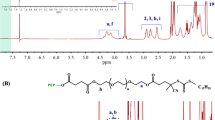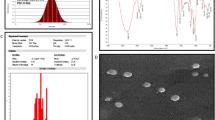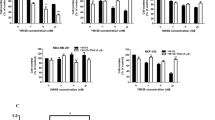Abstract
Despite the promising anti-cancer properties of the polyoxometalates (POMs) compound, they have not yet been reported for clinical use due to their general toxicity. This study reports the synthesis of tocopherol succinate (TS)-polyoxomolybdate (POMo) conjugate (T2POMo) as a novel organic–inorganic hybrid conjugate of POMo and evaluating its anti-cancer properties in vitro. The aim was to introduce a more potent derivative with less general toxicity than initial POMo to cancer treatment studies. The T2POMo conjugate was synthesized using amide bond formation between POMo and TS based on the carbodiimide strategy. The chemical structure of T2POMo conjugate was fully investigated and confirmed using spectroscopy and elemental analysis techniques. The anti-cancer properties of T2POMo conjugate were evaluated on Brest (MCF-7) and prostate cancer (LNCAP) cell lines carefully by the MTT protocol, and the general toxicity was studied on human umbilical vein endothelial cells (HUVEC) similarly. Finally, the quantity of induced apoptosis was carefully evaluated using the flow cytometry technique for the T2POMo conjugate compared to POMo. The cytotoxicity studies showed that tocopherol succinate conjugation altered and regulated the activity and seems to induce great synergistic cytotoxic effects on cancerous cell lines. The half-maximal inhibitory concentration (IC50) on the MCF-7 cell line was about 167.3 μg/mL, and on the LNCAP cell line was about 234.1 μg/mL. The cytotoxicity of T2POMo was significantly greater than that of POMo, and the toxic effects on normal cells were significantly reduced. Flow cytometry results showed that the hybrid conjugate could produce about 61% of apoptosis in the MCF-7 cell line than POMo (36%) alone. Therefore, tocopherol succinate hybrid conjugate (T2POMo) can be introduced as a promising potent anti-cancer agent to further pre-clinical studies.











Similar content being viewed by others
Explore related subjects
Discover the latest articles and news from researchers in related subjects, suggested using machine learning.References
WHO (2018), https://www.who.int/news-room/fact-sheets/detail/cancer
E. Dickens, S. Ahmed, Principles of cancer treatment by chemotherapy. Surgery 36(3), 134–138 (2018)
H.-K. Yang, Y.-X. Cheng, M.-M. Su, Y. Xiao, M.-B. Hu, W. Wang et al., Polyoxometalate–biomolecule conjugates: a new approach to create hybrid drugs for cancer therapeutics. Bioorg. Med. Chem. Lett. 23(5), 1462–1466 (2013)
D. Karimian, B. Yadollahi, V. Mirkhani, Dual functional hybrid-polyoxometalate as a new approach for multidrug delivery. Microporous Mesoporous Mat. 247, 23–30 (2017)
A. Bijelic, M. Aureliano, A. Rompel, Polyoxometalates as potential next-generation metallodrugs in the combat against cancer. Angew. Chem. Int. Ed. 58(10), 2980–2999 (2019)
T. Yamase, H. Fujita, K. Fukushima, Medical chemistry of polyoxometalates. Part 1. Potent antitumor activity of polyoxomolybdates on animal transplantable tumors and human cancer xenograft. Inorg. Chim. Acta. 151(1), 15–18 (1988)
C. Sabarinathan, M. Karthikeyan, B.R. Harisma, R.M. Murugappan, T. Arumuganathan, One pot synthesis of luminescent polyoxometalate supported transition metal complex and biological evaluation as a potential larvicidal and anti-cancer agent. J. Mol. Struct. 1206, 127486 (2020)
X.-H. Li, W.-L. Chen, Y.-G. Li, P. He, Y. Di, M. Wei et al., Multi-functional rare earth-containing polyoxometalates achieving high-efficiency tumor therapy and visual fluorescence monitoring. Inorg. Chem. Commun. 104, 40–47 (2019)
Y.-F. Song, N. McMillan, D.-L. Long, S. Kane, J. Malm, M.O. Riehle et al., Micropatterned surfaces with covalently grafted unsymmetrical polyoxometalate-hybrid clusters lead to selective cell adhesion. J. Am. Chem. Soc. 131(4), 1340–1341 (2009)
G. Geisberger, S. Paulus, E.B. Gyenge, C. Maake, G.R. Patzke, Targeted delivery of polyoxometalate nanocomposites. Small 7(19), 2808–2814 (2011)
H. Zhao, L. Tao, F. Zhang, Y. Zhang, Y. Liu, H. Xu et al., Transition metal substituted sandwich-type polyoxometalates with a strong metal–C (imidazole) bond as anti-cancer agents. Chem. Commun. 55(8), 1096–1099 (2019)
D. Ventura, A. Calderan, C. Honisch, S. Krol, S. Serratì, M. Bonchio et al., Synthesis and biological activity of an Anderson polyoxometalate bis-functionalized with a B ombesin-analog peptide. Pept. Sci. 110(5), e24047 (2018)
M. Li, C. Xu, L. Wu, J. Ren, E. Wang, X. Qu, Self-assembled peptide-polyoxometalate hybrid nanospheres: two in one enhances targeted inhibition of amyloid β-peptide aggregation associated with Alzheimer’s disease. Small 9(20), 3455–3461 (2013)
A. Boulmier, X. Feng, O. Oms, P. Mialane, E. Rivière, C.J. Shin et al., Anti-cancer activity of polyoxometalate-bisphosphonate complexes: synthesis, characterization, in vitro and in vivo results. Inorg. Chem. 56(13), 7558–7565 (2017)
M.S. Hosseini, S.H. Javanmard, L. Rafiei, A.A. Hariri, N. Dana, M. Rostami, Anti-cancer activity of biotin-polyoxomolybdate bioconjugate. Eur. J. Med. Oncol. 4(1), 42 (2020)
C.W. Wei, Y.L. Yu, Y.H. Chen, Y.T. Hung, G.T. Yiang, Anti-cancer effects of methotrexate in combination with α-tocopherol and α-tocopherol succinate on triple-negative breast cancer. Oncol. Rep. 41(3), 2060–2066 (2019)
N. Duhem, F. Danhier, V. Pourcelle, J.-M. Schumers, O. Bertrand, LeDuff CcS et al., Self-assembling doxorubicin–tocopherol succinate prodrug as a new drug delivery system: synthesis, characterization, and in vitro and in vivo anti-cancer activity. Bioconjug. Chem. 25(1), 72–81 (2014)
S.A. Orabi, M.T. Abdelhamid, Protective role of α-tocopherol on two vicia faba cultivars against seawater-induced lipid peroxidation by enhancing capacity of anti-oxidative system. J. Saudi Soc. Agric. Sci. 15(2), 145–154 (2016)
A.C. Mamede, S.D. Tavares, A.M. Abrantes, J. Trindade, J.M. Maia, M.F. Botelho, The role of vitamins in cancer: a review. Nutr. Cancer 63(4), 479–494 (2011)
B. Liu, L. Han, J. Liu, S. Han, Z. Chen, L. Jiang, Co-delivery of paclitaxel and TOS-cisplatin via TAT-targeted solid lipid nanoparticles with synergistic antitumor activity against cervical cancer. Int. J. Nanomed. 12, 955 (2017)
A.K. Mehata, S. Bharti, P. Singh, M.K. Viswanadh, L. Kumari, P. Agrawal et al., Trastuzumab decorated TPGS-g-chitosan nanoparticles for targeted breast cancer therapy. Colloid Surf. B Biointerfaces 173, 366–377 (2019)
M.S. Hosseini, S.H. Javanmard, L. Rafiei, A.A. Hariri, N. Dana, M. Rostami, Anti-cancer activity of biotin-polyoxomolybdate bioconjugate. Eur. J. Med. Oncol. (2020). https://doi.org/10.14744/ejmo.2020.34747
A.P. Ginsberg, Inorganic Synthesis (Wiley, Hoboken, 1990).
G. Calabrese, J.J. Nesnas, E. Barbu, D. Fatouros, J. Tsibouklis, The formulation of polyhedral boranes for the boron neutron capture therapy of cancer. Drug Discov. Today 17(3), 153–159 (2012)
P.R. Marcoux, B. Hasenknopf, J. Vaissermann, P. Gouzerh, Developing remote metal binding sites in heteropolymolybdates. Eur. J. Inorg. Chem. 2003(13), 2406–2412 (2003)
J. Ni, T. Mai, S.-T. Pang, I. Haque, K. Huang, M.A. DiMaggio et al., In vitro and in vivo anti-cancer effects of the novel vitamin E ether analogue RRR-α-tocopheryloxybutyl sulfonic acid in prostate cancer. Clin. Cancer Res. 15(3), 898–906 (2009)
S.K. Vashist, Comparison of 1-ethyl-3-(3-dimethylaminopropyl) carbodiimide based strategies to crosslink antibodies on amine-functionalized platforms for immunodiagnostic applications. Diagnostics 2(3), 23–33 (2012)
G. Geisberger, E.B. Gyenge, D. Hinger, P. Bösiger, C. Maake, G.R. Patzke, Synthesis, characterization and bioimaging of fluorescent labeled polyoxometalates. Dalton Trans 42(27), 9914–9920 (2013)
D.M. Morgan, Tetrazolium (MTT) assay for cellular viability and activity, in Polyamine Protocols. (Humana Press, New Jersey, 1998), pp. 179–184
R.I. Freshney, Culture of specific cell types, in Culture of Animal Cells: A Manual of Basic Technique. (Wiley, Hoboken, 2005)
Y. Shi, J. Yin, Q. Peng, X. Lv, Q. Li, D. Yang et al., An acidity-responsive polyoxometalate with inflammatory retention for NIR-II photothermal-enhanced chemodynamic antibacterial therapy. Biomater. Sci. 8(21), 6093–6099 (2020)
L. Fu, H. Gao, M. Yan, S. Li, X. Li, Z. Dai et al., Polyoxometalate-based organic-inorganic hybrids as antitumor drugs. Small 11(24), 2938–2945 (2015)
N. Liang, S. Sun, X. Li, H. Piao, H. Piao, F. Cui et al., α-Tocopherol succinate-modified chitosan as a micellar delivery system for paclitaxel: preparation, characterization and in vitro/in vivo evaluations. Int. J. Pharm. 423(2), 480–488 (2012)
B. Xu, Y. Wei, C.L. Barnes, Z. Peng, Hybrid molecular materials based on covalently linked inorganic polyoxometalates and organic conjugated systems. Angew. Chem. Int. Ed. 40(12), 2290–2292 (2001)
N.I. Gumerova, A. Rompel, Polyoxometalates in solution: speciation under spotlight. Chem. Soc. Rev. 49, 7568–7601 (2020)
A. Blazevic, E. Al-Sayed, A. Roller, G. Giester, A. Rompel, Tris-functionalized hybrid anderson polyoxometalates: synthesis, characterization, hydrolytic stability and inversion of protein surface charge. Chem. Eur. J. 21(12), 4762–4771 (2015)
P.W. Sylvester, S.J. Shah, Mechanisms mediating the antiproliferative and apoptotic effects of vitamin E in mammary cancer cells. Front. Biosci. 10(1–3), 699 (2005)
E. Pierpaoli, V. Viola, F. Pilolli, M. Piroddi, F. Galli, M. Provinciali, γ-and δ-tocotrienols exert a more potent anti-cancer effect than α-tocopheryl succinate on breast cancer cell lines irrespective of HER-2/neu expression. Life Sci. 86(17–18), 668–675 (2010)
Atlas thp. RNA cell line categoryi: Cell line enhanced (GAMG, SK-BR-3, T-47d, U-2 OS, U-2197, https://www.proteinatlas.org/ENSG00000137561-TTPA/cell#rna
Q.-X. Zhu, T. Shen, R. Ding, Z.-Z. Liang, X.-J. Zhang, Cytotoxicity of trichloroethylene and perchloroethylene on normal human epidermal keratinocytes and protective role of vitamin E. Toxicology 209(1), 55–67 (2005)
M. Pagano, C. Faggio, The use of erythrocyte fragility to assess xenobiotic cytotoxicity. Cell Biochem. Funct. 33(6), 351–355 (2015)
C. Riccardi, I. Nicoletti, Analysis of apoptosis by propidium iodide staining and flow cytometry. Nat. Protoc. 1(3), 1458–1461 (2006)
V.A. Zamolo, G. Modugno, E. Lubian, A. Cazzolaro, F. Mancin, L. Giotta et al., Selective targeting of proteins by hybrid polyoxometalates: interaction between a bis-biotinylated hybrid conjugate and avidin. Front. Chem. 6, 278–288 (2018)
Acknowledgements
We acknowledge Pharmaceutical Sciences Research Center’s financial support, School of Pharmacy and Pharmaceutical Sciences, Isfahan University of Medical Sciences, Grant Number; 297079.
Author information
Authors and Affiliations
Corresponding author
Ethics declarations
Conflict of interest
The authors declare that they have no conflict of interest.
Additional information
Publisher's Note
Springer Nature remains neutral with regard to jurisdictional claims in published maps and institutional affiliations.
Rights and permissions
About this article
Cite this article
Hosseini, M.S., Haghjooy Javanmard, S., Dana, N. et al. Novel Tocopherol Succinate-Polyoxomolybdate Bioconjugate as Potential Anti-Cancer Agent. J Inorg Organomet Polym 31, 3183–3195 (2021). https://doi.org/10.1007/s10904-021-01998-z
Received:
Accepted:
Published:
Issue Date:
DOI: https://doi.org/10.1007/s10904-021-01998-z




